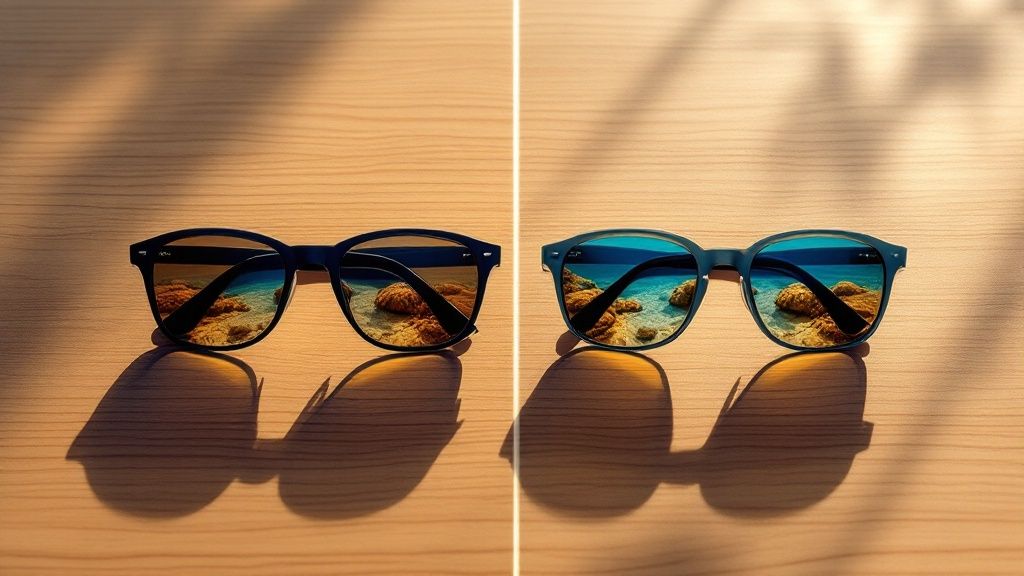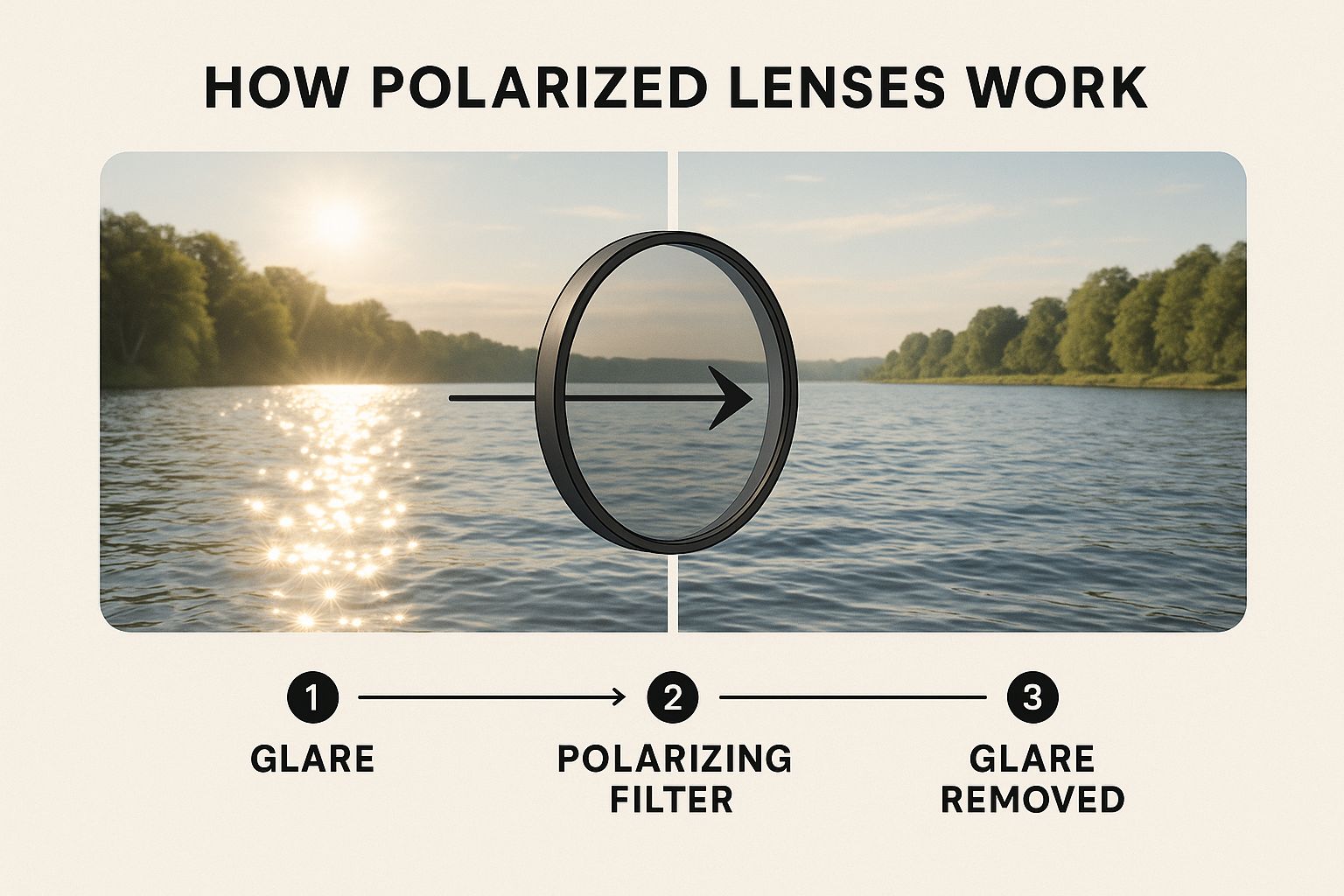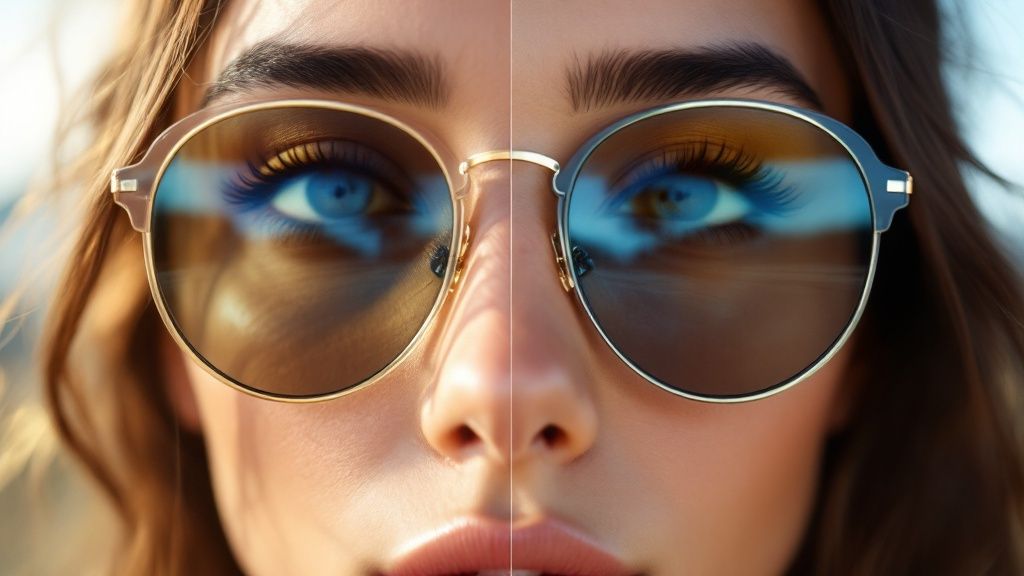
Polarized Lenses vs Non Polarized: Which Is Better?
When you're picking out a new pair of sunglasses, the whole polarized lenses vs non polarized discussion really comes down to one thing: glare. It's the blinding, reflective light that bounces off flat surfaces like water, snow, or a wet road. While both types of lenses cut down on brightness and should offer 100% UV protection, only polarized lenses have a special filter built in to eliminate that intense glare. Non-polarized lenses just turn down the volume on everything, but polarized lenses clean up the picture for a crisper view.
Understanding the Core Difference
At first glance, you can't really tell polarized and non-polarized sunglasses apart. They might look identical, but the technology inside them is solving two very different visual issues. Think of non-polarized lenses like a simple dimmer switch for the world—they reduce the intensity of all the light hitting your eyes. This is great for just making a bright day feel less harsh.
Polarized lenses, on the other hand, are a lot smarter about what they do. They're designed with a chemical filter that works like a set of microscopic vertical blinds. This filter only lets vertical light waves pass through while blocking the horizontal light waves that create glare. So, it doesn't just dim the scene; it actually boosts the contrast and visual definition, making everything look sharper and more vibrant.
The real win with polarization isn't just about comfort—it's about better visual performance. By cutting out that distracting glare, these lenses can seriously reduce eye strain and fatigue, especially if you're outdoors for a long time.
This key distinction is why your choice matters so much. It all depends on where you'll be and what you'll be doing. To make it simple, let's break down the key features side-by-side.
Quick Comparison Polarized vs Non Polarized Lenses
Deciding between the two can be tricky, so here’s a quick rundown to help you see the main differences in an instant. This table sums up what each lens type does best.
| Feature | Polarized Lenses | Non-Polarized Lenses |
|---|---|---|
| Glare Reduction | Excellent; eliminates 99%+ of reflected glare | Minimal; only reduces overall brightness |
| Visual Clarity | High contrast and enhanced definition | Standard clarity, scene is just darker |
| Ideal Situations | Driving, fishing, boating, snow sports | General daily use, viewing LCD screens |
| Price | Typically more expensive | Generally more affordable |
Ultimately, the right choice comes down to how you plan to use your sunglasses. For high-glare environments, the benefits of polarization are impossible to ignore.
The market is certainly showing a clear preference. The global polarized sunglasses market was valued at around USD 14.03 billion and is expected to jump to USD 20.12 billion by 2030. This growth shows that more and more people are choosing the superior visual experience that polarized lenses offer, especially for an active lifestyle. You can read more about the polarized sunglasses market growth and see why so many people are making the switch.
How Polarization Technology Eliminates Glare
To really get the difference between polarized and non-polarized lenses, you have to understand a little bit about how light behaves. Sunlight is naturally scattered, traveling in all sorts of directions—up, down, and sideways. Most of the time, this diffused light is pretty easy on our eyes.
But things change when that sunlight hits a flat, reflective surface. Think of a wet road, a calm lake, or even the hood of your car. Suddenly, those scattered light waves get organized and concentrated, bouncing back mostly in a horizontal direction. This is what we experience as intensely bright, blinding glare.
The Science Behind the Filter
This is where polarization technology steps in. A good way to visualize it is to think of a set of vertical blinds on a window. They only let light pass through the vertical gaps, blocking light that tries to come in from other angles. A polarized lens does the exact same thing, just on a microscopic level.
The lens is coated with a special chemical that creates a vertical filter. This filter is designed to block those pesky horizontal light waves that cause glare, while still allowing the more comfortable vertical light to pass right through. It’s a smart system—it’s not just about making everything darker, but selectively filtering out the harshest, most distracting light.
This image shows exactly how the filter blocks horizontal glare reflecting off a lake, leaving you with a much clearer, more comfortable view.
As you can see, polarization isn't about dimming the world. It’s about enhancing what you see by getting rid of the reflective light that gets in the way.
More Than Just Darkness
On the other hand, non-polarized lenses simply use a dark tint to reduce the intensity of all light equally. This definitely helps on a bright day, but it does absolutely nothing to target the specific problem of glare. Polarized lenses, by zeroing in on and eliminating those horizontal waves, deliver a much crisper and clearer visual experience.
By canceling out reflected glare, polarized lenses can reduce eye strain and improve depth perception in high-glare environments. This makes them an exceptional tool for activities where visual precision is key.
This targeted approach is what gives polarized sunglasses a huge advantage in so many outdoor situations. If you want to dive deeper into all the specific perks, you can learn more about the benefits of polarized sunglasses and see how they can improve your daily activities. The technology isn’t just about protection; it’s about superior visual performance that makes your time outdoors safer and way more enjoyable.
When Non-Polarized Lenses Are the Smart Choice
While polarization is a powerhouse for cutting down glare, it’s not the perfect tool for every single situation. In fact, there are plenty of times when a high-quality, non-polarized lens isn't just a preference—it’s a practical necessity. The main job of these lenses is to simply reduce overall brightness through their tint, giving you great comfort and vital UV protection without messing with how you see certain types of information.
The biggest case for non-polarized lenses pops up in our screen-saturated world. That special filtering technology in polarized lenses can cause some pretty significant visual hiccups with LCD and LED displays.

Technology and Screen Compatibility
If you rely on digital screens for key information, polarization can quickly turn into a real headache. It often makes the screens on your smartphone, GPS, or even the digital dashboard in your car look distorted, weirdly dim, or just completely black from certain angles.
This happens because those screens already put out polarized light. When the filter in your sunglasses clashes with the light coming from the screen, it literally blocks your view.
For professionals who depend on an unobstructed view of their screens for safety and navigation, non-polarized lenses are the only reliable option. This is exactly why they are the standard for airline pilots and many boat captains.
Just imagine a pilot glancing down at critical flight instruments only to find the screen unreadable. Or a driver whose GPS blacks out right before a crucial turn. In these moments, the clear, consistent view you get from a non-polarized lens is far more important than cutting glare. This is a huge factor in the polarized lenses vs non polarized debate for anyone operating vehicles or equipment with digital displays.
Specific Scenarios and Low-Light Conditions
Beyond just professional use, non-polarized lenses are often a better bet for activities in low-light or overcast conditions. On a cloudy day or in a deeply shaded forest, polarized lenses can sometimes make your surroundings look darker than they really are, which might hide important details on the trail ahead. Along those same lines, some people find that polarization can throw off their depth perception on uneven ground, a big concern for skiers or mountain bikers trying to read the terrain.
Sometimes, actually seeing a patch of glare can be a good thing. A driver in winter, for instance, might want to spot icy patches on the road, which often show up as intense glare. Polarized lenses would wipe that visual warning right out. It's for similar safety reasons that understanding how different lenses work at night is so important, which is why we break down the specifics in our guide to night driving glasses benefits and dangers.
Choosing Polarized Lenses For Your Lifestyle
Knowing the science is great, but the real question in the polarized lenses vs non polarized debate is how they actually perform when you’re out in the world. The right choice isn’t just about the technology itself; it's about matching that tech to what you do every day. For a lot of people, the way polarized lenses cut down glare is a complete game-changer.
You can see this pretty clearly in the sports and outdoor world, where polarized sunglasses command a massive 57.6% market share. That's not just a passing trend. It’s a direct result of the practical edge they provide, like better contrast and less eye fatigue, which are essential for both performance and safety. You can discover more insights about the sports sunglasses market to get a feel for why so many athletes and adventurers won't go without them.
For Anglers and Boaters
If you've ever been out on the water, you know how blinding the glare off the surface can be. It’s like a shimmering wall of light that makes it impossible to see anything underneath. This is exactly where polarized lenses shine, cutting through that harsh reflection with incredible clarity.
For anglers, this means actually spotting fish below the surface. For boaters, it’s about identifying hidden rocks or shallow sandbars. It makes a world of difference, turning a day of squinting and frustration into one where you can see clearly and comfortably.
For water-based activities, polarization is not a luxury—it’s a fundamental tool. It enhances safety and performance by providing a clear, unobstructed view of the underwater environment.
For Drivers on the Road
Glare is a relentless and dangerous problem when you're driving. It bounces off wet roads after it rains, reflects off the shiny hoods of other cars, and beams directly into your eyes when the sun is low. All of this leads to serious eye strain and can slow down your reaction time.
Polarized lenses are fantastic at tackling these specific kinds of glare. By filtering out that intense horizontal light, they make road lines look sharper, cut down on the blinding flash from other vehicles, and help you see more clearly on long trips. The result is a much safer and less stressful drive, with your eyes feeling noticeably fresher.
For Skiers and Hikers
Winter sports and high-altitude treks come with their own unique glare problems. A snow-covered landscape can reflect more than 80% of the sun's UV rays, creating an environment so bright it can cause snow blindness and major eye fatigue.
Polarized lenses are a huge help here. They cut through the intense reflections, which makes your time on the slopes far more comfortable and even improves your depth perception. Skiers and snowboarders can spot the difference between an icy patch and fresh powder, while hikers can read the terrain with more confidence. It makes every adventure safer and visually sharper, helping you see the beautiful contours of the snow instead of just a wall of white.
Deciding between lens types really boils down to what you'll be doing. To make it simple, let's break down some common scenarios and see which lens comes out on top.
Best Use Cases for Polarized vs Non Polarized Lenses
| Activity / Environment | Recommended Lens Type | Reasoning |
|---|---|---|
| Fishing & Boating | Polarized | Cuts blinding surface glare, allowing you to see beneath the water to spot fish or hazards. Essential for safety and performance. |
| Driving | Polarized | Significantly reduces glare from wet roads, other cars, and low sun, which helps minimize eye strain and improve reaction time. |
| Skiing & Snowboarding | Polarized or Non-Polarized | Polarized is great for reducing intense snow glare. However, some skiers prefer Non-Polarized to better distinguish icy patches, as polarization can sometimes mask them. |
| Hiking & Trail Running | Polarized | Enhances contrast and clarity, helping you see the trail better. Reduces glare from rocks and foliage, making for a more comfortable experience. |
| Aviation (Pilots) | Non-Polarized | CRITICAL: Pilots must use non-polarized lenses to avoid distorting or blacking out LCD screens and digital instruments in the cockpit. |
| Casual Everyday Use | Either (Personal Preference) | For walking around town or relaxing outdoors, it's up to you. Polarized offers superior comfort, but Non-Polarized is perfectly fine for general use. |
| Screen Usage Outdoors | Non-Polarized | If you frequently use a smartphone, tablet, or laptop outside, non-polarized lenses are better as they won't cause screen distortion. |
| Golfing | Non-Polarized | Many golfers prefer non-polarized lenses because they provide a more natural view of the green's contours and breaks without altering depth perception. |
Ultimately, the right lens is the one that best fits your daily life and activities. Keep this table in mind when you're choosing your next pair of Spektrum glasses to ensure you get the perfect visual experience.
How to Choose the Right Eyewear for Your Needs
Picking the right lenses goes way beyond the technical specs—it really boils down to your daily life. When you're weighing polarized vs. non-polarized, the best choice comes from looking at your typical activities, how sensitive you are to glare, and how much time you spend looking at digital screens. It’s all about finding the perfect fit for your world.
First, let's clear up a common myth: darker lenses don't automatically mean more UV protection. That's simply not true. Whether you choose polarized or non-polarized, any quality lens from a brand like Spektrum Glasses will offer 100% UV protection, no matter the tint. The real difference lies in how they handle visible light and, most importantly, glare.

A Simple Decision-Making Framework
To make things easy, just ask yourself these three questions about your lifestyle. Your answers will steer you straight toward the right lens technology for what you do.
-
Where do I spend most of my time outdoors? If you’re often driving, out on the water, or surrounded by snow, polarized lenses are the undisputed champion for cutting down that intense, blinding glare. For more general use in places without tons of reflective surfaces, non-polarized lenses will do the job just fine.
-
How often do I use digital screens outside? If your job or lifestyle has you constantly glancing at a smartphone, GPS, or another LCD screen while you're outdoors, non-polarized lenses are the more practical pick. They let you see your screen clearly, avoiding the weird distortions and blackouts that polarization can cause.
-
What about indoor screen time? It’s important to remember that neither polarized nor non-polarized sunglasses are meant for indoor screen use. To protect your eyes from the digital strain caused by computers and phones, you need specialized blue light glasses. We always recommend our PROSPEK glasses for their superior blue light filtering.
Beyond just cutting glare, proper UV protection is critical for your long-term eye health, especially in bright environments. For instance, if you're into water sports, a good snorkeling UV protection guide can offer deeper insights into keeping your eyes safe from the sun's reflection off the water.
The right pair of glasses should feel like a natural extension of your vision—enhancing clarity where you need it most without creating new problems. Your primary activities are the best guide to making the right decision.
In the end, you might realize you need more than one type of eyewear. A lot of people find it useful to have a pair of polarized sunglasses for driving and another non-polarized pair for everything else. You can also explore other options, which we cover in our guide to photochromic vs polarized lenses. By taking a moment to think about your specific needs, you can choose with confidence.
Still Have Questions?
Deciding between polarized and non-polarized lenses can feel tricky. Let's clear up some of the most common sticking points to help you land on the right choice with total confidence.
Are Polarized Lenses Better for Your Eyes?
It's not about one being "better"—they just tackle different jobs. Any high-quality lens, polarized or not, should offer 100% UV protection. That's the non-negotiable part of keeping your eyes healthy long-term.
Polarized lenses go a step further by wiping out the harsh, reflected glare you get from surfaces like wet roads or water. This single feature can massively cut down on eye strain and make you feel much more comfortable in bright, reflective situations, like when you're driving or out fishing.
How Can I Tell if My Sunglasses Are Polarized?
There's a really simple way to check this at home. Just grab your sunglasses and look at a modern LCD screen—your phone, a laptop, or even the display at the gas pump will work.
Now, tilt your head or rotate the glasses to about a 60-degree angle. If the lenses are polarized, the screen will dim significantly or go completely black. This happens because the filter in your lenses is blocking the polarized light coming from the screen.
This quick screen test is the most foolproof way to confirm polarization. Non-polarized lenses will just make the screen look a bit darker, but you'll still see the image clearly no matter how you tilt your head.
Do I Actually Need Polarized Lenses Every Day?
Honestly, it all comes down to your daily grind. If you do a lot of driving, especially during sunrise or sunset when the sun is low, they're a game-changer for safety and comfort. Same goes if you're often near water. The glare reduction is huge.
On the other hand, if your day involves a lot of outdoor screen time—checking your phone or working on a laptop in the sun—you might find non-polarized lenses more practical. They won't cause those weird dark spots or screen visibility issues that can pop up with polarized lenses.
What’s the Difference Between Polarized and Blue Light Glasses?
These two are built for entirely different worlds. Polarized lenses are your outdoor specialists, designed to combat the intense, blinding glare that bounces off surfaces in the sun.
Blue light glasses are your indoor shield. They're engineered to filter out specific wavelengths of blue light that pour out of digital screens. This helps fight digital eye strain and can even support better sleep. If you spend a lot of time on computers, you should consider a pair of PROSPEK glasses, which are specifically designed for this purpose.
Ready to match your lifestyle with the perfect eyewear? Spektrum Glasses has a premium collection of specialized lenses, all designed to sharpen your vision and protect your eyes, whether you're behind the wheel or behind a screen.
Explore Our Collection of High-Performance Eyewear at SpektrumGlasses.com
